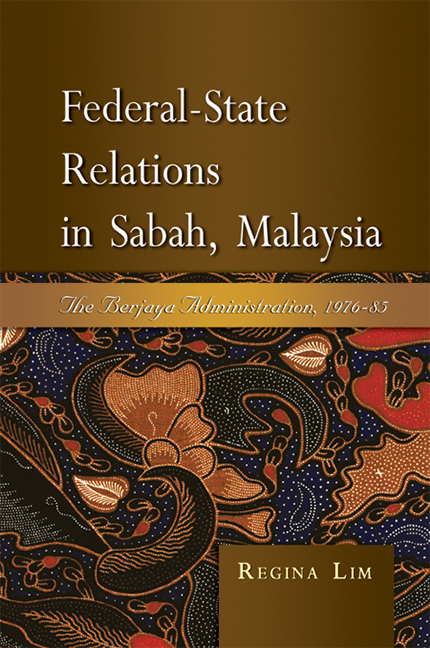Book contents
- Frontmatter
- Contents
- List of Tables and Figures
- Acknowledgements
- Abbreviations and Glossary of Terms
- 1 Introduction
- 2 Sabah Before Malaysia
- 3 Contesting the Rules of the Game, 1963–76
- 4 BERJAYA and Federal-state Relations
- 5 Development and Patronage
- 6 The Contest for Islamic Leadership and Multiracial Votes
- 7 Epilogue and Conclusion
- References
- Index
- About the Author
5 - Development and Patronage
Published online by Cambridge University Press: 21 October 2015
- Frontmatter
- Contents
- List of Tables and Figures
- Acknowledgements
- Abbreviations and Glossary of Terms
- 1 Introduction
- 2 Sabah Before Malaysia
- 3 Contesting the Rules of the Game, 1963–76
- 4 BERJAYA and Federal-state Relations
- 5 Development and Patronage
- 6 The Contest for Islamic Leadership and Multiracial Votes
- 7 Epilogue and Conclusion
- References
- Index
- About the Author
Summary
INTRODUCTION
Under BERJAYA, the discourse of development was used as a strategy for political support. In analysing the 1994 Sabah State election, Loh (1997) contended that the issue of development became central to the campaign tactics of the BN during the Mahathir Administration. The discourse of development was employed as a way to convince the Sabah electorate that the opposition government in Sabah, the PBS (Parti Bersatu Sabah, or Sabah United Party), had failed to bring progress and development to Sabah. The BN also introduced the slogan Sabah Baru (New Sabah) to denote a new image of Sabah as a developed state under the care of BN. Under the rhetoric of Sabah Baru, the BN pledged to build a university in Sabah, improve the education system, create low-cost housing, expand rural development programmes, and industrialize the Sabah economy. The ‘developmentalist’ approach or ‘politics of development’ was employed again in the 1999 Sabah State election, together with the successful manipulation of the ‘3Ms’: money politics, the BN electoral machine and the media (Loh 2003). The long list of development plans — forty-four of them published in the local newspaper in twelve days, from 28 February 1999 to 11 March 1999 — also contributed to the BN's success in the election (Loh 2003).
If the 1990s saw ‘development’ discourse in Sabah reach its apogee, it was under BERJAYA that Sabah began to experience the politicization of development on a broader scale. Long before the BN was promising a New [developed] Sabah if the PBS was ousted, Harris had made explicit the link between support for BERJAYA and the benefits of development. After the DAP won the Sandakan Federal constituency during the 1978 Federal election, Harris announced that “the Party BERJAYA's politics was the politics of development”. When the Sandakan electorate voted again for the DAP in the 1982 Federal election, Harris declared to the voters that there would be no development in Sandakan.
- Type
- Chapter
- Information
- Federal-State Relations in Sabah, MalaysiaThe Berjaya Administration, 1976–85, pp. 81 - 102Publisher: ISEAS–Yusof Ishak InstitutePrint publication year: 2008

